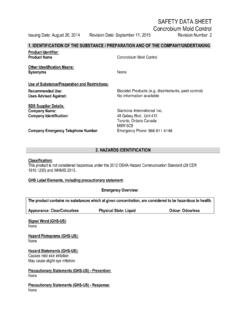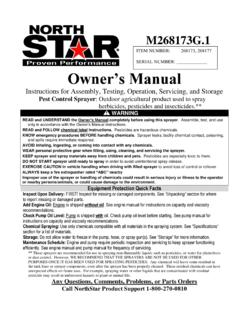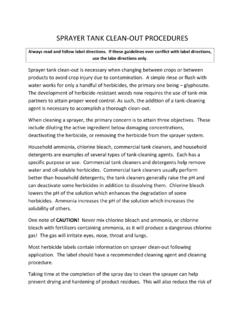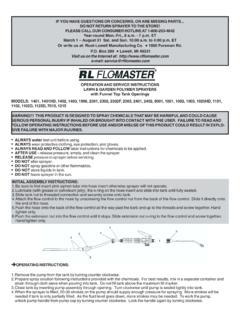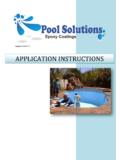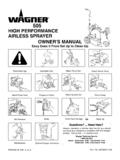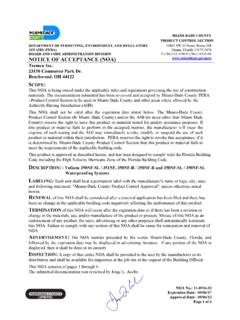Transcription of Instructions For Use - Concrobium
1 Instructions For Use Concrobium Mold Control dries on surfaces to create an invisible antimicrobial shield that kills and prevents mold, and gets rid of musty odours. The breakthrough, Health Canada approved solution contains no bleach, ammonia, alcohol or other VOCs and is suitable for use on almost any surface. IDEAL FOR. >Mold remediation in homes, businesses and institutions >Mold prevention following flooding or water damage cleanup >Pre-treatment of building materials for mold resistance Concrobium Mold Control can be used in homes, businesses, institutions, cottages, RVs, boats . anywhere that mold takes hold. General interior maintenance bathtubs, bathroom tiles, countertops, shower stalls, laundry rooms, walls, ceilings, around windows; musty basements, crawlspaces, attics Disaster restoration - mold remediation and prevention following flooding and leaks Construction and renovation pre-treatment of building materials ( drywall, lumber) for mold prevention; elimination of mold found during renovation Specialty mold clean-up and prevention Cars, RVs, boats, sporting equipment For use on finished and unfinished surfaces including: drywall, lumber, plaster, concrete, siding, shingles, composite decking, metal, marble, tile, grout, fabric, upholstery, furniture, clothing DIRECTIONS FOR USE.
2 Concrobium Mold Control can be used to clean and eliminate existing mold problems, and/or to prevent mold growth in vulnerable areas. In conjunction with using this product, it is highly recommended that the conditions favorable to mold growth (excess water, humidity) be identified and corrected. The product can be applied by a variety of application methods including hand-spray, paintbrush, roller, immersion, compression sprayer or cold (ULV) fogger (for more detailed fogging Instructions please consult the final section of this document). In all cases, the goal is to achieve a thin, even application on the surface, which must then be allowed to dry. As Concrobium Mold Control dries on moldy surfaces, it forms a hard polymer that physically crushes the mold micro-organisms underneath. That same polymeric barrier stays on surfaces to provide continual resistance against mold growth. Coverage varies according to surface and application method.
3 Fogging: approximately 1,400 sq ft. per gallon (the equivalent of a 20' x 20' room with 8. foot ceilings, all surfaces). Spray (manual or compression sprayer): approximately 600 sq ft per gallon on hard surfaces. Dip: approximately 1,000 sq ft. per gallon Expect reduced coverage on absorbent surfaces such as fabrics, carpet, lumber and unpainted drywall. Do not dilute. Do not rinse. Do not use bleach-based products in combination as this may reduce product efficacy. No special controls, ventilation, or personal protective equipment is required while handling the product. However, to avoid applicator exposure to mold or mold spores during use, consult product label section: "PERSONAL PROTECTION EQUIPMENT REQUIREMENTS FOR. APPLICATORS". PREVENTATIVE TREATMENT. To prevent the growth of mold and mildew on surfaces, simply: 1. Apply Concrobium Mold Control on area until evenly wet. 2. Allow treated surfaces to dry completely.
4 To maintain protection against mold re-growth, do not rinse or wash surfaces after Concrobium treatment. A thin, even layer of the product should remain on surfaces to prevent mold spore attachment. If surface is subsequently painted or coated with another substance, reapply Concrobium to ensure protection against mold. Materials vulnerable to water marks should be wiped immediately after contact with Concrobium Mold Control. Over-application may in some cases result in residue formation, which can be easily wiped away with a Concrobium Mold Control-dampened cloth. REMEDIAL TREATMENT. Areas of visible mold growth of less than 30 square feet (the area of a single wall panel) can normally be remediated without elaborate procedures. Areas larger than 30 square feet often require special procedures and individuals trained in remediation. Guidelines for remediation of large areas of contamination have been established by the Indoor Air Quality Associations ( ) and the US Environmental Protection Agency ( ).
5 Many in the field also refer to the New York City Department of Health, Guidelines on Assessment and Remediation of Fungi in Indoor Environments.. When moldy areas are identified, apply Concrobium Mold Control to eliminate existing mold and prevent the spread of fungal spores. If growth is on ceiling tiles or other such easily removable items of nominal value, consider removal and disposal of those items. If the surface is not easily replaceable: 1. Apply Concrobium on affected area until evenly wet. 2. Allow treated surfaces to dry completely. 3. Clean any remaining mold stains and residue with a Concrobium -dampened cloth or brush. REAPPLICATION. Reapplication of Concrobium Mold Control may be required if surfaces are washed or painted or are otherwise directly exposed to excessive water or rinsing. Surfaces that stay relatively dry and clean will remain continuously mold-resistant. PERSONAL PROTECTION EQUIPMENT REQUIREMENTS FOR APPLICATORS.
6 For areas less than 30 sq. feet, an N-95 respirator, gloves and goggles/eye protection are recommended to avoid exposure to mold or mold spores. For areas greater than 30 sq. feet, an N-95 respirator or half-face respirator with HEPA filter, disposable overalls, gloves and goggles/eye protection. Concrobium Mold Control Fogging Instructions Why Use a Fogger? A fogger atomizes Concrobium Mold Control into a fine mist that quickly and evenly coats surfaces. Fogging is ideal for treating and pre-treating various surfaces: Large spaces , entire rooms, basements, cellars Hard-to-reach areas , attics, crawlspaces Building materials , drywall, lumber, flooring, ceiling tiles, wood, concrete New home, building or institution construction sites , framed house General Fogging Directions Fogging Objective: to saturate air with Concrobium Mold Control fog such that the product spreads throughout the target area and coats surfaces with a thin, even layer.
7 Using the fogger as a sprayer to apply the product directly to surfaces may lead to over-application, which is not recommended. 1. Review Table 1 for approximate fogging time and product required. 2. Remove Fogger power head from tank. Add Concrobium Mold Control to fogger tank. Fasten clamps to secure power head. 3. Install intake air filter to help protect motor from mold spores and moisture in intake air. Intake filter installs over the louvers of rear housing of fogger. Attach the two adhesive backed hook fasteners to 10 and 2 o'clock positions, anchor bottom of filter and stretch elastic over housing. Filters can be cleaned and reused should they become soiled. 4. Remove or cover any room contents that may be damaged if wetted , furniture, electronics, electrical sources, paper products. 5. Adjust liquid flow rate knob at side of fogger head (Low, Med, High). The liquid flow rate determines the size of the fog droplets formed by the machine.
8 A Medium flow rate is recommended for application of Concrobium Mold Control. 6. Position and activate fogger in space being treated to ensure that a mist is created that fills the space. Adjust fogger head angle as required to ensure appropriate throw of fogged product. Fog target space according to fogging time recommendations in Table 1. 7. Do not over-apply product on surfaces. Run-off and pooling is a sign of over-application. 8. When fogging is complete, open reservoir, remove suction tube from liquid source and operate fogger for one minute with flow rate set at high. This will remove remaining liquid from fogger's internal lines. 9. After fogging, allow fog to dissipate for 15-20 minutes. Where possible, wipe off any excess wetness from surfaces, particularly flat, horizontal ones, with a clean cloth. 10. After fog has dissipated for required time, open windows and/or ventilate area to allow air exchange.
9 11. Allow surfaces to dry overnight. Do not rinse. It may be necessary to wipe some surfaces clean after drying , glass and mirrors. Room Fogging Tips 1. If fogging an entire room, fogger should be placed in middle of room - about 4' off floor, for 8' ceilings and 6', for 10' ceilings adjust height for higher ceilings. Aim fogger towards join line between ceiling and wall. 2. Start fogging on medium flow rate. Rotate fogger continuously to ensure an even fog ( , a quarter turn every two minutes). More frequent rotation or adjustments to the flow rate may be required if run-off or pooling develops. NOTE: Each area requires its own treatment considerations re. product quantity, application duration, fogger positioning and rotation technique. It may be necessary to apply product for a longer period, in certain directions, to compensate for room dimensions a long narrow room. Fogger radius during treatment is 30 feet; it will be necessary to re-position fogger for rooms with dimensions greater than this.
10 Mounting the fogger on a self-rotating turntable is a good way to achieve even application. See retailer for details. Table 1. Area* Approximate Total Fogging Time Product Required 180 sq ft (12' x 15' room, 8'. 15-20 minutes at Med setting 2 L. ceilings**). 400 sq ft (20' x 20' room, 8'. 30-40 minutes at Med setting 1 4 L. ceilings**). *Area assumes surface coverage of all walls, floors and ceilings. **Allow more time for rooms with higher ceilings Fogger Operation Guidelines Use only a cold (ULV) fogger to fog Concrobium Mold Control. Do not use thermal foggers. Use only Concrobium Mold Control with your fogging machine. Do not apply any liquid that is hazardous to people, animals or property when atomized into small droplets. Avoid over-exposure to fog output. While Concrobium Mold Control contains no bleach, ammonia, alcohol, acids or VOCs, highly atomized droplets can float in the air a long time and are quickly absorbed by the lungs.
